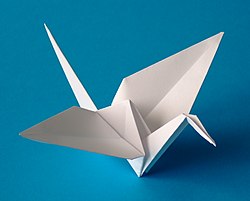Oritsuru
Tampilan
(Dialihkan dari Tsuru)

Oritsuru[1] atau orizuru (折鶴, ori = "lipat"; tsuru = "bangau"), yang berarti bangau kertas, adalah suatu origami paling klasik yang berbentuk burung.[2] Ia merupakan representasi bangau mahkota-merah yang memiliki makna signifikan dalam kebudayaan Jepang. Oritsuru biasanya dipakai sebagai hiasan seremonial atau dekorasi meja restoran.[3] Ia dapat juga dipakai sebagai model matematis.[4] Seribu oritsuru yang digantung bersamaan disebut senbazuru (千羽鶴), artinya "seribu bangau".
Cara melipat
[sunting | sunting sumber]
|
Referensi
[sunting | sunting sumber]Wikimedia Commons memiliki media mengenai Oritsuru.
- ^ https://kbbi.kemdikbud.go.id/entri/oritsuru
- ^ The East 1970 Page 293 "Follow the instructions on the next page. Crease the paper tightly, and you will obtain clear-cut J forms. The first in our series is the orizuru (folded crane), which is the most classic of all Japanese origami. The process of folding is not so simple."
- ^ Patsy Wang-Iverson, Robert J. Lang, Mark Yim Origami 5: Fifth International Meeting of Origami Science 2011 Page 8 "The older pieces are ceremonial wrappers, including ocho and mecho, and the newer ones are the traditional models we know well, such as the orizuru (crane) and yakko-san (servant) [Takagi 99]."
- ^ Mathematical reviews American Mathematical Society, Mathematical Association of America 2004 Page 349 "The author describes how to fold the orizuru and the generalized orizuru from paper other than a square. Many figures explain the procedure."
